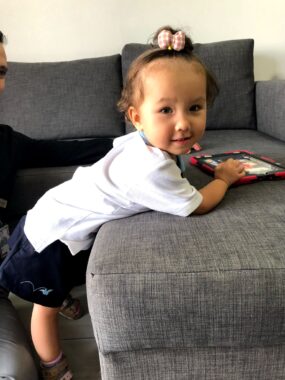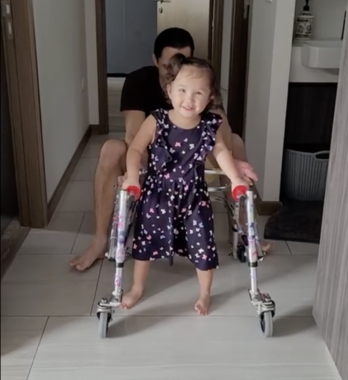The power of human touch supports the use of a walker
Micro-adjustments helped our daughter with AADC deficiency learn to walk
Written by |

For most parents, watching their child take their first steps is a moment of joy and celebration. For my wife, Judy, and me, it was also a moment that followed countless hours of patience, experimentation, and teamwork.
The journey to walking for our daughter, Rylae-Ann, wasn’t a straightforward path because of her aromatic l-amino acid decarboxylase (AADC) deficiency. Instead, it was marked by small victories, deep intuition, and unwavering support.
In the beginning, Judy and I didn’t rely on equipment. Instead, our physical therapist guided us to focus on body weight and natural support. We used our own bodies as scaffolds. By sitting behind Rylae-Ann, holding her under the arms or gently guiding her posture, we helped her become familiar with standing, shifting her weight, and building strength in her legs.

Rylae-Ann leans against the sofa with an iPad to learn to stand and eventually walk. (Courtesy of Richard E. Poulin III)
Judy and I also made use of simple things at home. The sofa became one of our key tools. We’d prop Rylae-Ann’s chest up against it while playing her favorite videos on the iPad. That allowed her to lean slightly forward, transferring some weight through her arms and chest while still engaging her lower body. Her legs learned what it meant to bear weight, even if just a little at a time.
Judy and I would sit behind Rylae-Ann to give a helping hand or a gentle nudge of encouragement to continue standing as long as possible. When she needed a break, our hands would guide her into a secure sitting position. Once she had a short break, our hands once again guided her into a standing position while leaning against the sofa.
Later, Judy introduced exercises that involved Rylae-Ann performing sitting and standing routines using blocks. These provided her with the stability she needed while encouraging her independence. Once she could sit independently without support, we knew she was ready for the next step: using a walker.
Using a walker, not a crutch
Introducing the walker marked a significant turning point. It provided Rylae-Ann with more freedom to explore movement and encouraged a new level of independence. But Judy and I were mindful not to let her become dependent on it. We used it intentionally and sparingly. We treated it as a tool and not a crutch.
During some sessions, she’d walk with the support of a walker. At other times, we’d go back to the basics, helping her stand using only her own strength and our bodies.

Rylae-Ann uses a walker to work up to walking. (Courtesy of Richard E. Poulin III)
Our philosophy was simple: Use the walker to build confidence, but always return to the natural supports that allowed her to feel and understand her own strength.
This process wasn’t just about equipment or exercises; it was also about connection. As parents, we became highly attuned to her needs, her signals, and the subtle shifts in her body. Through physical touch, we made micro-adjustments. Slightly adjusting the tilt of her pelvis, guiding her feet into the proper position, or giving just enough pressure to help her engage her core.
These adjustments were small, almost imperceptible, but incredibly powerful. The power of human touch, combined with love and consistency, became the most essential tool in our journey.
It was a long road, filled with trial and error, but also filled with hope. Step by step, literally, she grew stronger. Together, we found a rhythm. We had an unspoken understanding between us and our daughter that eventually led her to learn to walk on her own.
Looking back, we’re proud of how far Ryale-Ann has come. The walker played a vital role, but it was never the entire solution. It was the combination of human connection, patience, and purposeful support that helped her reach this milestone.
And each step she takes today is a reminder of how powerful love and teamwork can be.
Note: AADC News is strictly a news and information website about the disease. It does not provide medical advice, diagnosis, or treatment. This content is not intended to be a substitute for professional medical advice, diagnosis, or treatment. Always seek the advice of your physician or other qualified health provider with any questions you may have regarding a medical condition. Never disregard professional medical advice or delay in seeking it because of something you have read on this website. The opinions expressed in this column are not those of AADC News or its parent company, Bionews, and are intended to spark discussion about issues pertaining to aromatic l-amino acid decarboxylase deficiency.




Leave a comment
Fill in the required fields to post. Your email address will not be published.